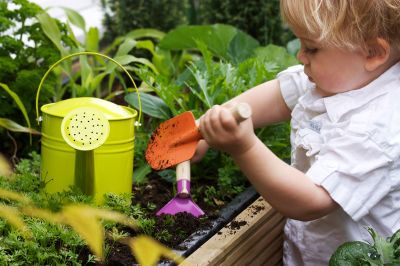About Garden Tools for Kids
A few ideas for child-sized gardening tools include rakes, hoes, and spades. These are basic necessities and are often sold in sets. These smaller versions of grown-up tools are best for kids ages seven and up. Watering cans are fun (especially for toddlers) and in this case, a sturdy, lightweight plastic watering can is more practical. Make sure the size is appropriate, as full watering cans can be too heavy for little ones. Gardening gloves should be a habit for gardeners of all ages. They keep little hands clean and free of stickers, splinters, and insect bites. Be sure the gloves are breathable, and that they fit snugly, but not too tight. Hand tools such as a trowel, spade, and shovel are suitable for slightly younger children, beginning at about age five. Many hand tools come in sets, often with a brightly colored tote bag. Wheelbarrows are available in a variety of sizes, and they’re just right for kids that like to haul things. Child-sized wheelbarrows don’t hold as much, but they’re sturdy enough for a small load of mulch or a few leaves, and they don’t tip easily.
Tips on Using Children’s Gardening Tools Safely
When it comes to choosing tools for kids, it’s best to spend a little more and invest in sturdy tools, such as those with metalheads and wooden handles. Plastic tools may be okay for the youngest gardeners (toddlers), but cheap garden tools for kids can be frustrating and take much of the fun out of gardening. Teach kids that gardening tools can be dangerous, including shovels, rakes, hoes, and trowels. Children’s gardening tools aren’t toys, and children should be shown how to properly use them in their intended way. Remind them to carry garden tools with the pointed ends facing down. Similarly, rakes, shovels, and garden forks should never be placed on the ground with the tines or blades facing up. So that children can learn basic care for their tools, get them in the habit of cleaning and putting them away properly after each use.
